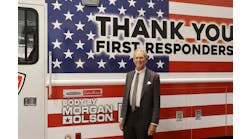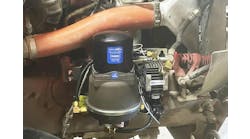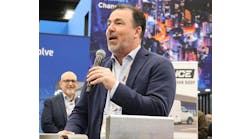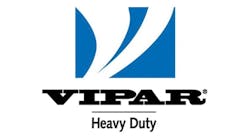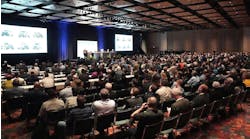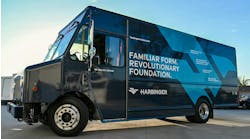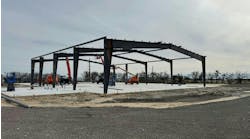In the beginning, some 80 years ago, Bert Gregoire started building trucks for farmers along the Red River in upper Minnesota/North Dakota. Three more generations of Gregoire boys later, Bert’s Truck Equipment is still in business, both in East Grand Forks, home of the original, and at the “new” store that opened in 1976 down the river in Moorhead, MN, just across the bridge from Fargo.
The need for the new location was simple: Too many Gregoires, explains Jeremy Gregoire, president of the Moorhead business. Jeremy is the great-grandson of Bert. When Jeremy’s grandfather, Lloyd, bought out Bert, Jeremy’s father, Kent, “saw the writing on the wall,” as Jeremy explains it.
“There were all the brothers, just a year apart, and they all wanted to work in the business,” Jeremy says. “He saw there were too many people involved [in the original location], and he was the one who took the took the gamble to come down here where my grandfather set him up.”
His cousins in East Grand Forks own and operate that business, while Jeremy and brother Jeff bought the Moorhead business seven years ago. Kent still owns the buildings and collects rent, and occasionally comes by the store “to stir the pot a little.”
“There’s always challenges [working with family], but 95% of it is very, very good,” Jeremy says.
Of Jeremy’s three kids, the oldest—a senior in high school—has shown some interest in the family business.
But as Jeremy explains, he himself had other plans when he finished high school, and he spent two years at the US Air Force Academy in Colorado Springs, where he also played hockey.
“I kind of figured [the academy] wasn’t for me, so I came back here and started working part time, finished up school in town and I’ve been involved ever since,” he says.
During his more than 20 years at the business, he’s “done it all,” from working in the warehouse to parts delivery to sales before running the service shop. Since becoming president, Jeremy says he’s tried to get away from day-to-day responsibilities to focus on “bigger picture” decisions.
“Some days I can, but most days I can’t,” he laughs.
Business shift
Among his strategic decisions, Jeremy moved the business away from being dependent on the local agriculture market, transitioning to the municipal and construction segments.
“Everything was a grain box in the back of a tandem axle truck, that’s all we did,” he recalls. “That was Bert’s bread and butter forever. Now we might do a few a year.”
About 25% of the Moorhead business today is building municipal plow trucks, with customers including the state of North Dakota and Minnesota, along with numerous cities, counties and townships. Key suppliers include Falls Plows, Bonnell, Crysteel, Bibeau and Knapheide.
“It feels like a big part of our business just because it’s big trucks,” Gregoire says. “And then we do everything else: service bodies, flatbeds, a lot of Boss snowplows in the winter—we even sell the mobility vans with the ramps in them.”
The mobility business is growing rapidly, currently 15% of Bert’s revenue in Moorhead.
“More and more people need the mobility vans, and we can sell and service them,” he says.
The facility features five buildings, with close to 60,000 square feet of retail, shop and warehouse space; that includes 6,000 square feet of shop added a year ago. All told, the shop now features 15 stalls and a new truck wash area.
“We just needed more space for the things inside,” Jeremy says. “There were just too many days when we’re working with half a truck sticking out the door—that’s fine during the summer but it’s difficult in the winter.
“Before we were always plugged up with just the basic jobs we were doing—installing flat beds, or whatever it may be. And we’re trying to keep two stalls open so we can get things in and out quicker, for just little drive-up repairs.”
The store employs 35 people full time. But as the business grows, filling new technician positions has been a slow process. As is typical for a rural community, many hires come recommended by current employees.
“We’ve got a really good crew that we’ve kept on for a long time, but every time I have to add one it’s a challenge,” he said. “We’ve got a good crew and we try and treat them right—so they stay around.”
Like many upfitters, Bert’s has experienced problems with chassis deliveries this year. Because the store doesn’t sell the chassis, customers understand the delay is not Bert’s fault—but that doesn’t mean they don’t still need the equipment they’ve ordered as soon as possible.
“I have a list of trucks that were supposed to be here in June and July that aren’t going to be here until November. It’s a real challenge,” he said. “When the chassis does show up, it’s late and the customer wants it now. So it’s a lot of pressure on our guys to get it done quick and properly.
“Thankfully, there’s enough work so we’re able to keep everything busy and going all the time. But it is frustrating trying to get equipment and chassis here at the same time. The hard part is we’ve got a lot more inventory sitting here than I would like—stuff that we’ve ordered and told our suppliers we need by July 1, and they get it to us but the chassis is not here. And sometimes it’s the other way around.”
On the other hand, Jeremy credits the equipment manufacturers he represents with keeping him updated on any pricing issues.
And, again like other upfitters, he continues to have customers who want Bert’s to install equipment, even items he carries, that they’ve bought online.
“There’s not going to be any deals on labor, that’s for sure,” Jeremy says. “And usually, it is what it is. If it takes us eight hours, we’re going to bill for eight hours. It’s definitely a challenge, but for the most part, it hasn’t gotten to be too big of a problem yet.”
Looking ahead
As for long-term plans, Jeremy doesn’t have any major moves in the works. His goal as owner and manager is simply to improve the processes, and to give his team the resources they need—whether that’s shop space or better equipment and new technology—to do their jobs well which, in turn, keeps customers coming back.
“I don’t want to grow to five states or anything. I’m a hands-on guy, and I don’t need any more headaches,” he says. “I’m just always trying to keep fine-tuning things, getting more efficient and finding ways to keep the employees happy, to keep the family atmosphere going.”
Another 80 years for Bert’s? Look for the story here in 2099.
